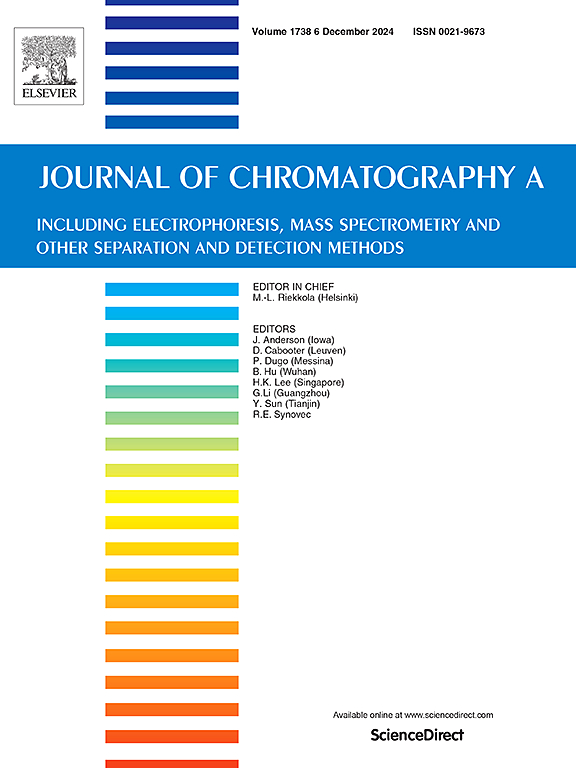Development of amphiphilic hypercrosslinked porous polymers for magnetic extraction of multiple environmental pollutants in water
IF 3.8
2区 化学
Q1 BIOCHEMICAL RESEARCH METHODS
引用次数: 0
Abstract
Under the principle of similar compatibility, researchers have developed various polarity extractants corresponding to a class of chemicals. Separating different polarities chemicals with one extractant effectively has become a novel research trend in separation science. Given the complexity of environmental sample matrices and the significant differences in polarity and solubility of various compounds, the introduction of hydrophilic groups to hydrophobic material skeletons can lead to sorbents with hydrophilic-lipophilic balance (HLB) property and thus improve their extraction performance for substances with different polarities. In this work, a hypercrosslinked polymer (HCPPz-TPB), designated as HLB, was synthesized by incorporating polar pyrazine and nonpolar triphenylbenzene molecules within each other. Subsequently, a core-shell magnetic composite material was obtained by encapsulating magnetic Fe3O4 nanoparticles in HCPPz-TPB. The material was applied as an adsorbent for magnetic solid phase extraction (MSPE) and combined with a high-performance liquid chromatography-photodiode array detector (HPLC-PDA) to enrich, separate, and detect seven polar contaminants in environmental water samples. The proposed approach, Fe3O4@SiO2@HCPPz-TPB−MSPE-HPLC-PDA, is characterized by its outstanding high sensitivity, low detection limits, wide linear range, and good reproducibility. The method demonstrated satisfactory linearity in the range of 0.05–2 μg mL-1 with R2 values between 0.9969 and 0.9997; the limits of detection (LOD) were observed to be within the range of 0.0019–0.016 μg L-1, and limits of quantification (LOQ) was observed to be within the range of 0.0064–0.054 μg L-1 range with good precision. The recoveries of the different contaminants in the environmental samples ranged from 83.61 to 116.46% (RSD≤10.56, n = 5). The new hydrophilic-lipophilic balance extractant is highly efficient, sensitive, and precise for extracting different polar pollutants. The findings demonstrate that the Fe3O4@SiO2@HCPPz-TPB display a remarkable affinity for multiple targets, driven by complex interactions including multi-stackings and hydrogen bonding as a sorbent. The synthesized Fe3O4@SiO2@HCPPz-TPB may be employed in diverse applications, including extraction, removal, and determination of diverse trace multi-target analytes in complex media.
开发用于磁性萃取水中多种环境污染物的两性超交联多孔聚合物
根据相似相容的原理,研究人员开发出了与一类化学品相对应的各种极性萃取剂。用一种萃取剂有效地分离不同极性的化学物质已成为分离科学的新研究趋势。鉴于环境样品基质的复杂性以及各种化合物极性和溶解度的显著差异,在疏水材料骨架上引入亲水基团可以产生具有亲水-亲油平衡(HLB)特性的吸附剂,从而提高其对不同极性物质的萃取性能。在这项工作中,通过将极性吡嗪分子和非极性三苯基苯分子相互结合,合成了一种超交联聚合物(HCPPz-TPB),并命名为 HLB。随后,通过在 HCPPz-TPB 中封装磁性 Fe3O4 纳米粒子,得到了核壳磁性复合材料。该材料被用作磁性固相萃取(MSPE)的吸附剂,并与高效液相色谱-光电二极管阵列检测器(HPLC-PDA)相结合,用于富集、分离和检测环境水样中的七种极性污染物。所提出的 Fe3O4@SiO2@HCPPz-TPB-MSPE-HPLC-PDA 方法具有灵敏度高、检出限低、线性范围宽、重现性好等特点。该方法的线性范围为0.05-2 μg mL-1,R2为0.9969-0.9997;检出限(LOD)为0.0019-0.016 μg L-1,定量限(LOQ)为0.0064-0.054 μg L-1,精密度良好。环境样品中不同污染物的回收率为 83.61% 至 116.46%(RSD≤10.56,n = 5)。这种新型亲水亲油平衡萃取剂对不同极性污染物的萃取具有高效、灵敏和精确的特点。研究结果表明,Fe3O4@SiO2@HCPPz-TPB 作为一种吸附剂,在包括多重堆积和氢键在内的复杂相互作用的驱动下,对多种目标具有显著的亲和力。合成的 Fe3O4@SiO2@HCPPz-TPB 可用于多种应用,包括萃取、去除和测定复杂介质中的多种痕量多目标分析物。
本文章由计算机程序翻译,如有差异,请以英文原文为准。
求助全文
约1分钟内获得全文
求助全文
来源期刊

Journal of Chromatography A
化学-分析化学
CiteScore
7.90
自引率
14.60%
发文量
742
审稿时长
45 days
期刊介绍:
The Journal of Chromatography A provides a forum for the publication of original research and critical reviews on all aspects of fundamental and applied separation science. The scope of the journal includes chromatography and related techniques, electromigration techniques (e.g. electrophoresis, electrochromatography), hyphenated and other multi-dimensional techniques, sample preparation, and detection methods such as mass spectrometry. Contributions consist mainly of research papers dealing with the theory of separation methods, instrumental developments and analytical and preparative applications of general interest.
 求助内容:
求助内容: 应助结果提醒方式:
应助结果提醒方式:


